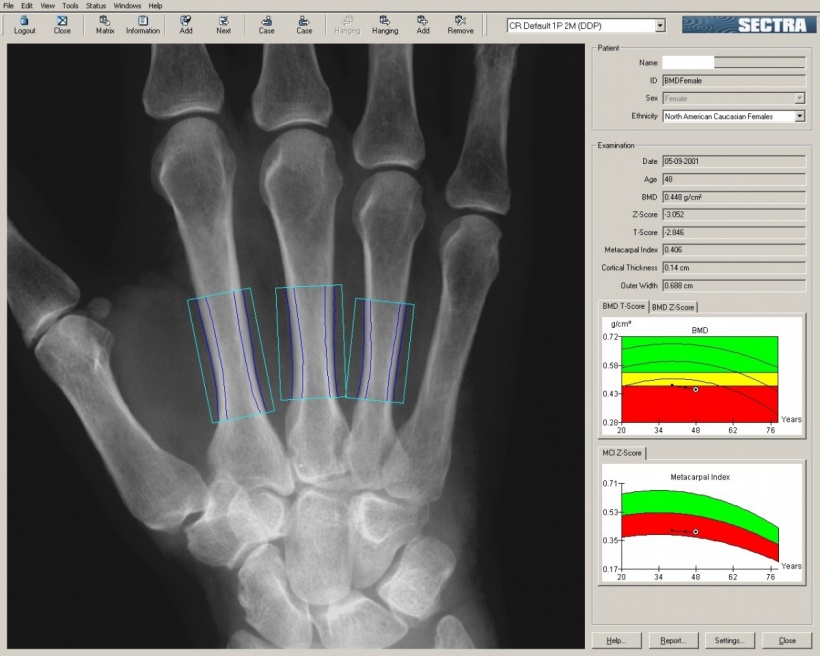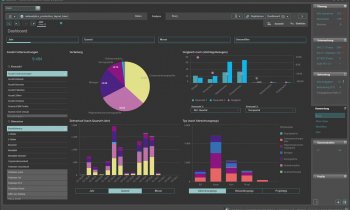Sponsored • Testing Bones
Osteoporosis risk assessments with DXR
Women over the age of 50 are not only at higher risk of developing breast cancer but also osteoporosis. Would it not be practical to use the same method to detect both diseases early on? Definitely, decided Sectra, the Swedish company specialising in PACS and mammography systems.
Based on international scientific studies and data, the company developed an algorithm that determines the risk of developing osteoporosis based on digital radiology images of the hand. The equipment used for image acquisition utilises the low-dose mammography modality.
First the breast and then why not the hand?

For women who would like to have their bone density assessed, the Schwabing Radiology practice, in Munich, has been offering the special OneScreen solution by Sectra for several years, under the direction of Dr Michael Risch. Following a mammogram, the same digital radiology equipment is used to take an additional X-ray of the hand. This is sent to a trained expert at Sectra in Sweden where it enters the PACS along with the mammography image. The expert checks whether all parameters important to the evaluation of the examination have been met – the metacarpal bones of the index finger, middle finger and ring finger being the important ones – and puts the images through a specially developed programme. ‘In our practice we offer three procedures to measure bone density: Quantitative Computed Tomography (QCT), Dual-energy X-ray Absorptiometry (DXA) and digital radiology examinations with low-dose mammography.
The latter are particularly suitable for early screening where there is no evidence of suspected disease as the procedure is carried out with only a very small radiation dose of just a few microsieverts,’ explains Dr Michael Risch, who has gained very good experience with the procedure with the initial selection of patients.
Apart from low radiation dose, the ease and speed of the examination particularly make the procedure highly attractive for routine medical practice. ‘Acquiring images is a matter of seconds and the evaluation is fully automated. This is extremely convenient and allows us to offer this service, which is not covered by the statutory medical insurers o patients at a reasonable price – quite a bit less than one hundred euros,’ he points out. ‘If, based on the Sectra evaluation, osteopenia, i.e. early stage osteoporosis, is diagnosed, further examinations are carried out for quantification and then treatment is recommended.

Global data comparison
Sectra OneScreen already allows significant conclusions about bone density, according to Maria Bolin, General Manager and head of Sectra’s Osteoporosis Division: ‘Our system measures more than 1,000 points on the metacarpal bones of the three middle fingers. The system evaluates the volume as well as the curvature of the bones and the data is then used to determine the estimated BMD (bone mineral density).The BMD is then correlated with that of the population of the same age group and additionally with the estimated peak bone mass point, i.e. the point in time at which all humans have their highest bone density, around the age of 30. In this way we create several comparisons and reference points for individual assessment.’
A huge reference database, compiled from different worldwide studies, is used as the basis for all those measurement. Naturally, the results of every examination fed into the OneScreen system in turn enhance this reference database.The OneScreen system is FDA approved, has the CE mark and is available to all users of mammography and digital x-ray. Currently, the only hindrance for the procedure’s comprehensive utilisation is the lack of reimbursement by the statutory health insurers in European countries. However, due to the comparatively small financial contribution required from patients the method doesn’t lose its overall attractiveness.
Source: Sectra
06.03.2015
- congresses (698)
- mammography (256)
- manufacturers (210)
- medical technology (1544)
- PACS (176)
- radiology (725)
- research (3457)
- studies (1062)











